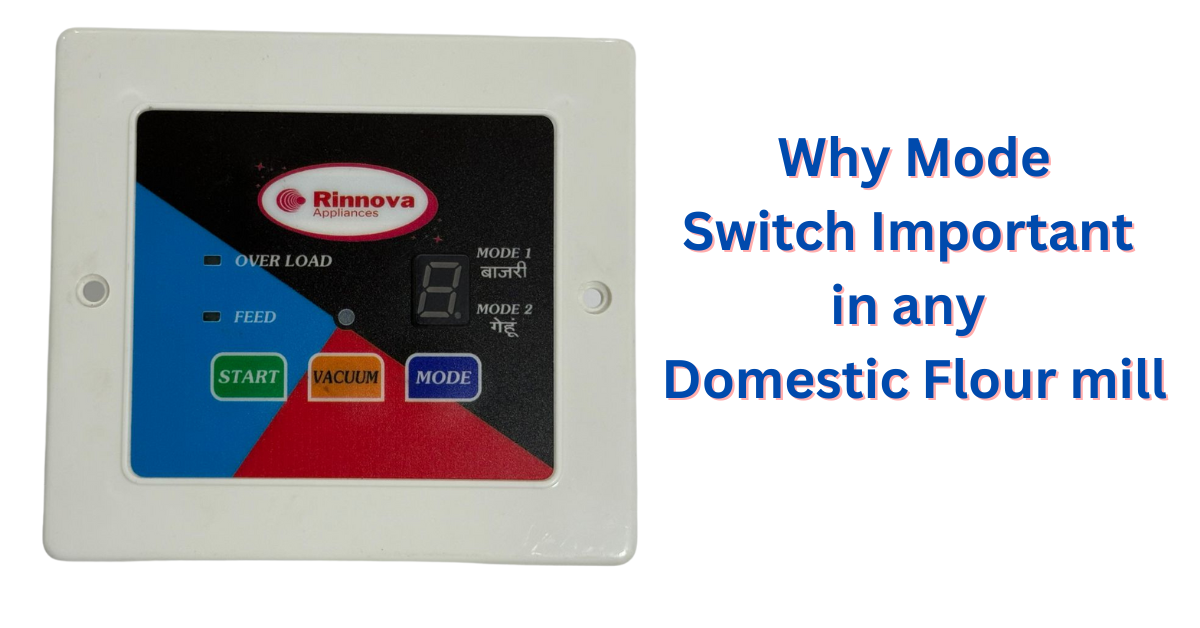Flour Grinding Machine have become an integral part of modern kitchens, allowing families to enjoy fresh, preservative-free flour at home. While most people focus on grinding capacity, motor power, and durability, one critical yet often overlooked feature is the grinding mode switch.
This smart mechanism plays a vital role in:
✔ Improving grinding quality
✔ Enhancing grinding speed
✔ Preventing motor overload
✔ Increasing efficiency and energy savings
So, how does the mode switch work, and why is it important? Let’s dive deep into this essential feature.

Understanding the Grinding Mode Switch Mechanism
The grinding mode switch operates based on the ampere load of the main motor. Different grains have different hardness and require varying levels of power for efficient grinding in all flour grinding machine.
To optimize performance, most domestic flour mills are equipped with two grinding modes:
- Mode 1: Designed for softer grains and millets such as Bajra, Jowar, and Ragi.
- Mode 2: Suitable for harder grains like Wheat, Chana Dal, and Maize (Makka).
By selecting the right mode, the flour mill adjusts its grain-feeding rate according to the real-time motor load, ensuring smooth and efficient grinding.
How the Grinding Mode Switch Works
Mode 1 – For Millets (Bajra, Jowar, Ragi, etc.)
- When this mode is selected, the atta chakki operates smoothly until the motor load reaches 3.5 to 3.7 Amperes.
- If the ampere load crosses 3.7, the grain-feeding motor temporarily stops.
- The small feeding motor resumes automatically once the ampere load drops back below 3.5.
- This ensures that lighter grains do not overload the motor and that the grinding remains uniform.
Mode 2 – For Wheat, Chana Dal, and Maize (Harder Grains)
- In this mode, the Flour grinding Machine operates efficiently until the motor load reaches 4.5 to 4.8 Amperes (varies based on brand).
- If the ampere load goes beyond 4.5, the grain-feeding motor stops temporarily.
- It restarts once the ampere load falls back below 4.5, preventing strain on the main motor.
This intelligent ampere-based control system optimizes the grinding process, ensuring better performance and longer machine life.
Why the Grinding Mode Switch is Crucial
✅ 1. Prevents Motor Overload & Extends Lifespan
Overloading a flour mill can cause the motor to overheat, reducing its lifespan and efficiency. The mode switch prevents this by adjusting the grain feed rate, ensuring that the motor runs within safe limits.
By preventing overload, the grinding mode switch reduces the chances of motor burnout, saving repair and replacement costs in the long run.
✅ 2. Ensures Consistent & High-Quality Grinding
The quality of flour depends on how evenly the grains are ground. If the flour mill motor struggles due to overload, grinding becomes inconsistent, resulting in coarse or uneven flour.
With the mode switch regulating the feed rate, the motor can operate smoothly, ensuring that every batch of flour is finely and evenly ground.
✅ 3. Improves Grinding Speed & Efficiency
If the flour mill is constantly overloaded, the atta chakki motor struggles, slowing down the grinding process. This can make flour production slower and more inefficient.
By maintaining optimal load levels, the grinding mode switch ensures that the flour mill grinds at the fastest possible speed without compromising quality. This means you can get fresh flour quicker and more efficiently.
✅ 4. Reduces Power Consumption & Saves Energy
When a motor runs at high ampere loads for long durations, it consumes excessive electricity, leading to higher energy bills.
By controlling the feed rate, the mode switch ensures that the motor only consumes as much power as needed, making the flour mill more energy-efficient. This not only saves electricity but also reduces heat generation, further protecting the motor.
✅ 5. Supports a Wide Range of Grains
Different grains have different hardness levels, and using the same grinding settings for all types can damage the flour grinding machine motor and reduce grinding quality.
The grinding mode switch allows users to easily switch between different grain types, ensuring that every grain is ground at the optimal speed and pressure. Whether you are grinding soft millets or hard wheat, the flour mill automatically adjusts to give the best results.
✅ 6. Makes the Flour Mill Smart & User-Friendly
Without a mode switch, users would have to manually adjust grain feeding or stop the machine frequently to prevent overload.
The automatic ampere-based control system eliminates this hassle by self-regulating the feed rate, making the flour mill easier and more convenient to use. Just select the right mode, and the machine takes care of the rest!
Final Thoughts: The Smart Choice for Your Kitchen
The grinding mode switch is not just a small feature—it’s a game-changer in domestic flour mills. It enhances performance, protects the motor, ensures better grinding quality, speeds up the process, and saves energy.
When choosing a flour mill for home use, make sure it comes with a smart mode switch to enjoy efficient, high-quality, and hassle-free grinding. With this feature, you can get fresh, pure, and finely ground flour every time—just like your grandmother used to make!
So, if you’re looking for the best flour mill with advanced mode switching technology, explore the range of ShreejiFine domestic flour mills today!




